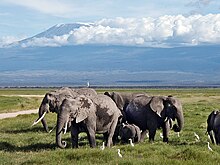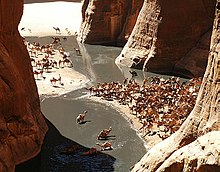Wild Africa
| Wild Africa | |
|---|---|
BBC Natural History Unit | |
| Original release | |
| Network | BBC Two |
| Release | 7 November – 12 December 2001 |
| Related | |
| |
Wild Africa is a British
The series forms part of the Natural History Unit's Continents strand. It was preceded by
Production
Wild Africa typifies the style of blue-chip documentary series on which the Natural History Unit has built its reputation, with its high production values, strong visuals and dedicated musical score. To achieve this took 18 months of principal photography on 53 filming trips to 22 countries, starting in September 1999. The filmmakers were assisted by a production team of 16 and around 140 scientists and field assistants.
The filming team travelled from the lowest point on the continent, the
Episodes
Broadcast dates refer to the original UK transmission.
1. "Mountains"
- Broadcast 7 November 2001

After an opening sequence introducing the series, the first episode looks at Africa's mountain ranges. First to be featured are the
2. "Savannah"
- Broadcast 14 November 2001
The
3. "Deserts"
- Broadcast 21 November 2001

The third programme features Africa's
4. "Coasts"
- Broadcast 28 November 2001
The fourth instalment follows an anticlockwise path around Africa's coastline, beginning at the
5. "Jungle"
- Broadcast 5 December 2001

The penultimate episode looks at the continent's rainforests, which cover equatorial Africa from
6. "Lakes and Rivers"
- Broadcast 12 December 2001
The final programme looks at how water influences life on the continent. Rain falling on the mountains of equatorial Africa eventually flows into
Awards
Wild Africa won two awards at the 2003 Jackson Hole Wildlife Film Festival in the Best Limited Series and Best Cinematography categories.[10] The series was also nominated for its photography at the 2001 BAFTA Craft Awards.[11]
Merchandise
A book, soundtrack CD, and DVD are all available to accompany the TV series:
- A Region 2 and 4, 2-disc DVD set was released on 18 July 2005 (BBCDVD1700) featuring all six full-length episodes and the bonus documentary "The Super Herd" from the Wildlife on One series. Wild Africa is one of four series which comprise the Region 1 DVD box set BBC Atlas of the Natural World: Europe and Africa, released on 2 October 2007.
- The accompanying hardcover book, Wild Africa by ISBN 0-563-53790-6).
- An original orchestral soundtrack CD, composed and conducted by Christopher Gunning, was released by BBC Music on 19 November 2001.
See also
- BBC Atlas of the Natural World, a 2006-07 DVD box set for North America
References
- ^ Gilsdorf, Ethan (19 November 2015). "Africa at its most alluring". The Boston Globe.
- ^ Production diary
- ^ Wild Africa DVD notes
- ^ Written and produced by Patrick Morris (7 November 2001). "Mountains". Wild Africa. BBC. BBC Two.
- ^ Written and produced by Amanda Barrett and Owen Newman (14 November 2001). "Savannah". Wild Africa. BBC. BBC Two.
- ^ Written and produced by Patrick Morris (21 November 2001). "Deserts". Wild Africa. BBC. BBC Two.
- ^ Produced by Marguerite Smits van Oyen (28 November 2001). "Coasts". Wild Africa. BBC. BBC Two.
- ^ Written and produced by Andrew Murray (5 December 2001). "Jungles". Wild Africa. BBC. BBC Two.
- ^ Written and produced by Julian Hector (12 December 2001). "Lakes and Rivers". Wild Africa. BBC. BBC Two.
- ^ Jackson Hole WFF News
- ^ BAFTA 2001 Awards Database
External links
- Wild Africa at BBC Online
- Wild Africa at BBC Online
- Wild Africa showreel at BBC Motion Gallery
- Wild Africa at IMDb
